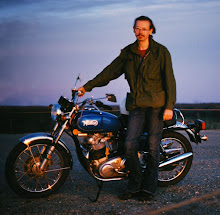Today marks the 15th anniversary of the tornado outbreak that began on the afternoon of 03 May 1999. That day, I was "head down" into my research at my NSSL office, not planning on chasing, because I always had much to do professionally before I went on my annual chase vacation. As the afternoon wore on, word filtered up from the SPC below (in the old NSSL building on North Campus) that the outlook had been upgraded to "high risk". Then, toward the end of my workday, about to leave for home, I drifted down to the research/operational workstation room that was next door to the SPC operations area. In checking out the developing storms, it seemed that the storms beginning to our southwest were left-movers and didn't pose much of a threat - but I thought "Well, it's going to be in my backyard, so I might as well go out and take a look-see." I hadn't brought my cameras, so I had to go home to fetch them. By the time I got home, a quick look at the TV showed a tornado in progress on live feed! I barreled out the door and got into the chase recounted here.
But I don't want to reminisce about that chase, per se, in today's blog post. Rather I want to consider the account (in that link above) of my damage surveys and how I feel about things today, with the passage of 15 years. I remember a talk I gave somewhere about storms and storm chasing - during the Q&A following the talk, someone asked me if I'd ever seen an F-5 tornado, and I'd responded, "No, the strongest tornadoes I've ever seen were only F-4s." I recall being mildly amused by the question, but also a bit offended by the implications. That question also reminds me of the scene in that awful movie Twister where the hero Bill Harding (played by Bill Paxton) is held in awe because he's the only one in their merry band who's actually seen an F-5. Somehow, it seemed my status as a chaser, as seen by others, was diminished because I'd not seen an F-5 tornado. Like an F-5 tornado was the chasing equivalent of a 12-point buck mounted on my wall.
After the incredible day's chase on 03 May 1999, I was pretty sure I'd seen my first F-5 tornado and that carried with it some sense of fulfillment - until the BPAT survey began, and I had another chance to see for myself, with my own senses, what tornadoes can do. I'd participated in other surveys before, included that done for the storied 24 May 1973 tornado that hit Union City, OK. That tornado had initiated some concern within me (see item #32, here) for the morality of storm chasing (see my previous blog) and I eventually resolved that concern when I remembered that my desire to see a tornado had absolutely no effect on the atmosphere. I was not responsible for the devastation of tornadoes, so my conscience was clear.
I hope my overall feeling of horror comes through in my personal account of the BPAT survey. In the days following the event, I felt a growing anger over the superficial and sensationalized media treatment of the 03 May 1999 outbreak. In retrospect, my real take-away from the survey was the realization that no one who had not experienced a devastating tornado could even begin to understand the feelings of the survivors. That feeling has been reinforced by a project reviewing the 1925 Tri-State tornado - it was clear by interviewing the survivors that the impact of their experiences still was felt strongly nearly more than 70 years later! As obvious as that seems to me now, it was something of a revelation then. With the passage of 15 years, that theme has come more and more to the forefront of my feelings about storms.
I haven't lost my fascination with tornadoes and the storms that produce them. I haven't lost the desire to go out and see them for myself. But as time passes and more events accumulate in the record books of tornadoes, it's become much more difficult than it used to be to detach myself from the tragedies they produce and stay focused on the science and the storm chasing experience. I understand why some people can view storm chasing as immoral or hostile activity, although I maintain that it's neither of those. When I think about the storms of 03 May 1999, it's no longer only in terms of the excitement of that chase. I now feel more strongly than ever that we professionals need to put more effort behind programs that can mitigate the awful consequences of a tornado in a populated area: improve our forecasts, support the imposition of more substantial building construction and the spread of suitable tornado shelters, and so on.
Rather than feeling a sort of wistful echo of my experiences as a chaser on 03 May 1999, I'm now reminded of the terrible feelings I had during the BPAT survey, talking with survivors and seeing first hand what this phenomenon can do to humans. How can I feel excited recalling a successful chase on that day when I think about what that storm did to the people in its path? It's taken me several decades of storm chasing to reach this point, so I certainly can understand some of the enthusiasm for the experience that relatively new chasers feel. I just hope they can begin to develop more empathy for the survivors and not let their excitement dominate that empathy.
The Incoming System
7 hours ago

